In a world inundated with AI-generated material, choosing the right AI detection tool is a decision that can significantly impact the success of your work. This guide will empower you to make an informed choice, considering factors such as accuracy, ease of use, pricing, and overall user experience.
What are AI Content Detectors?
In the realm of content creation, the surge in the use of artificial intelligence (AI) has given rise to tools known as AI content detectors. These sophisticated tools are designed to scrutinize and distinguish between content generated by humans and that crafted by AI algorithms. Whether it’s textual content or multimedia elements, AI content detectors utilize advanced algorithms to analyze patterns, styles, and characteristics, unveiling the fingerprints of AI in the creative process. Essentially, these detectors act as digital detectives, unmasking the origins of content to ensure transparency and authenticity in the ever-expanding landscape of AI-generated materials.
Benefits of Using an AI Content Detector
The adoption of AI content detectors brings forth a multitude of advantages:
- Content Authenticity: One of the primary benefits is the assurance of content authenticity. AI content detectors play a crucial role in verifying whether the content in question is human-generated or a product of AI algorithms. This is especially valuable in scenarios where clarity about the authorship of content is essential.
- Ethical Content Creation: With concerns about ethical content creation on the rise, AI content detectors serve as ethical guardians. They assist in identifying content that may have been generated unethically or without proper attribution, contributing to a more responsible and transparent digital environment.
- Quality Control: AI content detectors aid in maintaining quality standards. By differentiating between human and AI-generated content, these tools enable content creators and consumers to assess the reliability and accuracy of the material at hand, ensuring high-quality outputs.
- Time Efficiency: For businesses and content creators, time is a precious resource. AI content detectors streamline the process of verifying content origins, saving time that can be allocated to other critical tasks. This efficiency is particularly notable in the face of the prolific content generation facilitated by AI.
10 Top Recommended AI Content Detector Tools
As AI technology evolves, so do AI detector tools. The future holds the promise of even more sophisticated software capable of not only identifying AI-generated content but also pinpointing the specific AI model used.
Let’s explore some of the best AI detector tools available in 2023:
| Tool Name | Accuracy | Free Option | Rating |
|---|---|---|---|
| Undetectable.ai | 90% | Free (limited options) or paid | Product Hunt: 5/5, G2: 5/5 |
| Winston AI | 84% | Free with limitations | Capterra: 4/5 |
| Originality.ai | 76% | Pay-as-you-go or subscription | Product Hunt: 2.9/5 |
| GLTR | 72% | Free | Capterra: 4/5 |
| Sapling | 68% | Yes | G2: 4.2/5 |
| Content at Scale | 66% | Free with limitations | Capterra: 4/5 |
| Copyleaks | 66% | Yes | G2: 4.8/5, Capterra: 4.5/5 |
| Crossplag | 58% | Yes | G2: 4.6/5 |
| GPTZero | 52% | Yes | G2: 5/5 |
| Writer | 38% | Free | G2: 4.4/5, Capterra: 4.7/5 |
Undetectable.ai stands out for its in-depth analysis, going beyond a simple “AI or human?” response. It analyzes the structure, syntax, and stylistic elements of the text to provide a probability of AI involvement. Users can input content into its user-friendly interface, and the tool’s undetectability algorithms work behind the scenes to analyze language patterns.
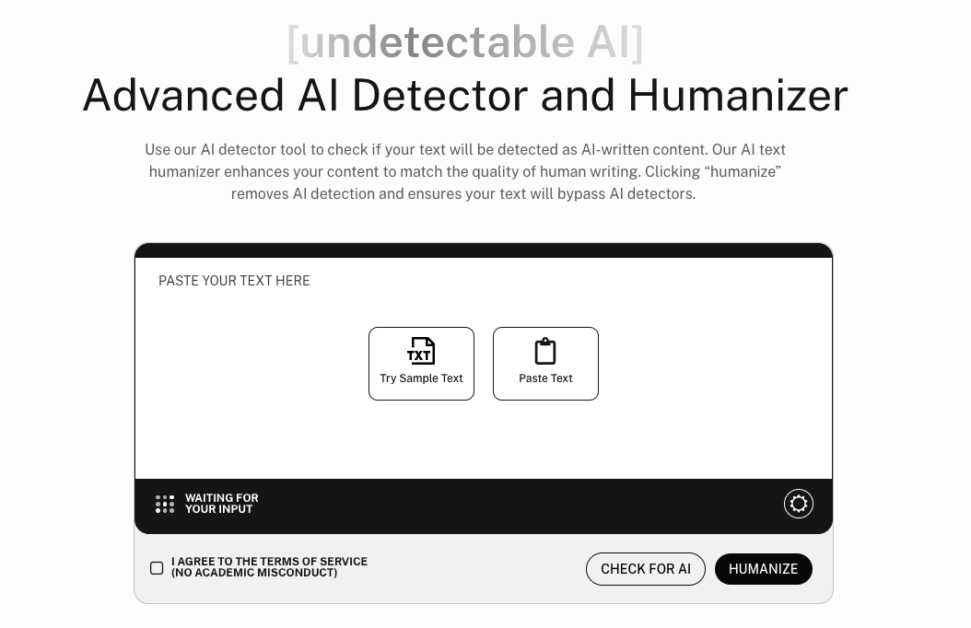
Key Features:
- Dual AI detection and humanization
- Analyzes up to 10,000 characters
- Intuitive user experience
- Identifies the latest AI models
Pros:
- High accuracy (85-95% detection rates)
- Supports 10,000 characters per analysis
- Flexible pricing plans
Cons:
- Affordability concerns for paid tiers
- Dated interface visuals
Best Suited For: Writers, bloggers, researchers, and content creators seeking to uncover AI-generated content.
Winston AI is a cloud-based AI detector tool designed for businesses to identify AI-generated content in various corporate communication channels. It offers a user-friendly interface where users can either copy and paste text or upload a file for analysis.
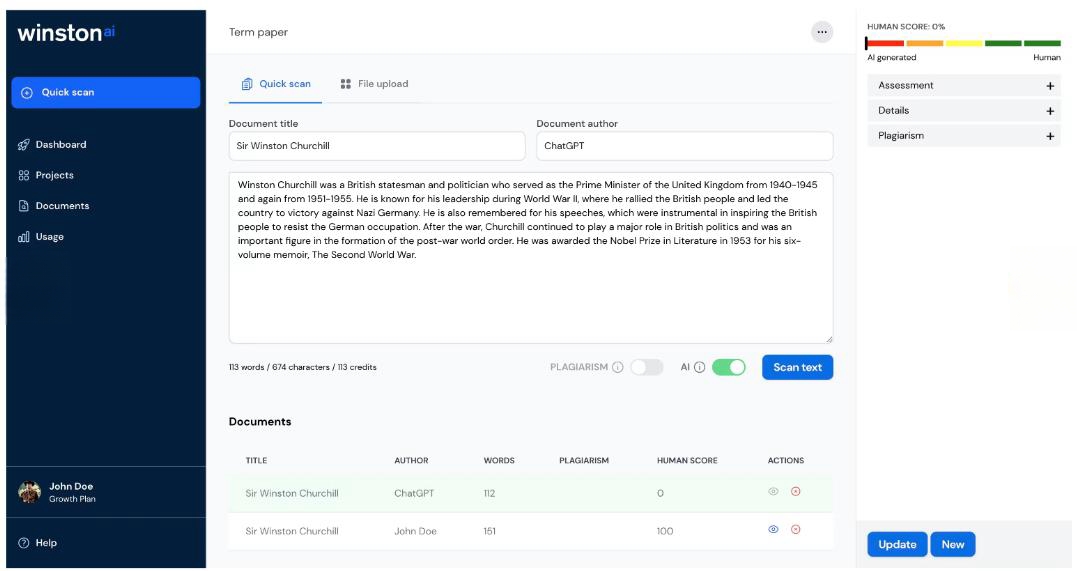
Key Features:
- High accuracy (up to 99.6%)
- Quick scan option
- OCR technology
- Multilingual support
Pros:
- Detects most AI content, including GPT-4 texts
- User-friendly AI detection interface
Cons:
- Costly for some users
- Limited free tier
Best Suited For: Writers, educators, web publishers, and students looking to detect AI-generated text in their content.
Originality.AI combines AI detection and plagiarism checking in a cloud-based tool. Using advanced machine learning, it claims to spot text created by leading AI models with high accuracy. It offers versatility through a Chrome extension, direct website scanning, and support for multiple languages.
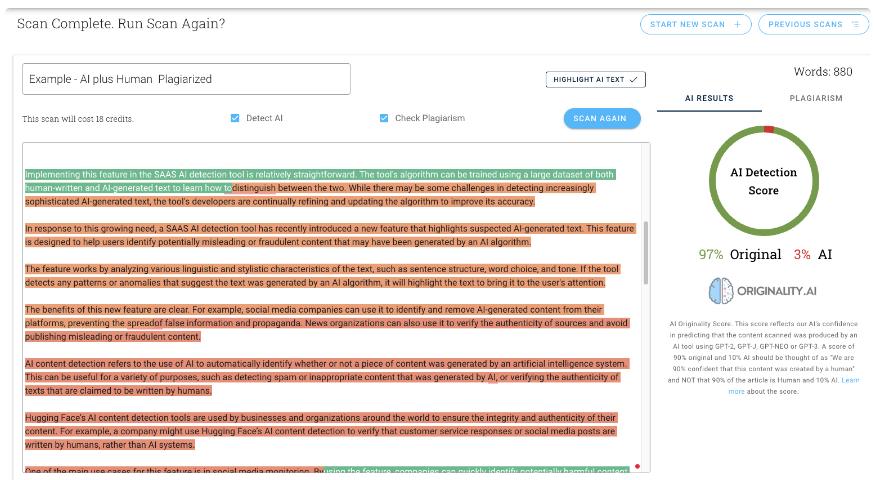
Key Features:
- Two-in-one AI & plagiarism detection
- Customizable sharing of detailed reports
- Readability scoring for further optimization
Pros:
- High accuracy (over 95%)
- Supports various analysis methods
Cons:
- User concerns over detection accuracy
- Restricted capabilities on pay-per-use pricing
Best Suited For: Teams and individuals seeking to validate content authenticity, particularly marketing/SEO agencies.
- GLTR (Giant Language model Test Room):
GLTR is an open-source AI detector tool based on GPT-2 technology. It focuses on word analysis to identify the likelihood of AI predictions. While not as accurate as some other tools, it provides insights into distribution patterns indicative of automated content.
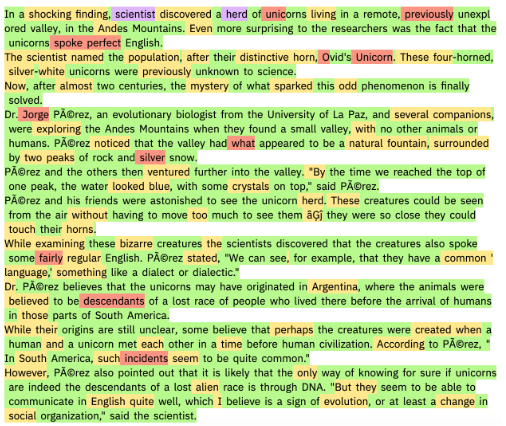
Key Features:
- Forensic text analysis
- Visual highlighting of suspect words
- Insights for accurate identification of computer-generated text
Pros:
- Free to use
- In-depth linguistic analysis
Cons:
- May not detect newer AI content
- Complex outputs for first-time users
Best Suited For: Researchers and developers looking for an open framework of linguistic analysis tools.
Sapling is an AI detector tool that focuses on detecting AI-generated content in text. It is designed for individuals and offers a free option for basic users. While not as accurate as some other tools, it provides a viable solution for those looking for a free option.
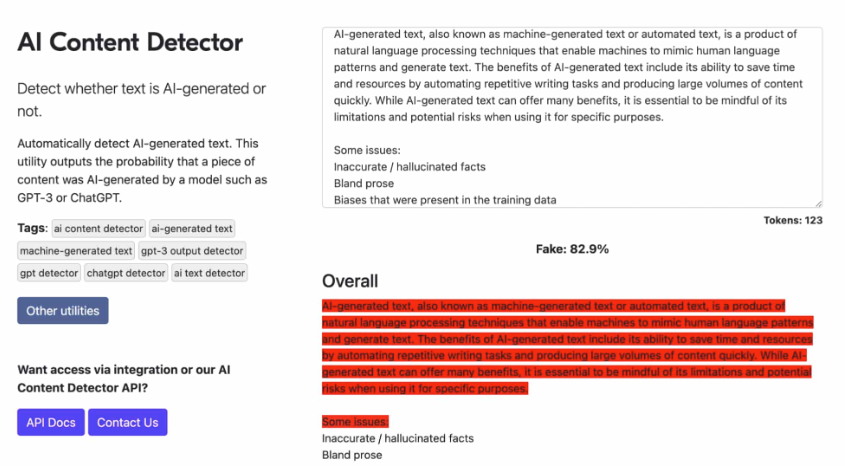
Key Features:
- Identifies various AI writing assistants
- Advanced deep learning algorithms
Pros:
- Free to use
- No sign-up required
Cons:
- Not as accurate as some other tools
- Limited in handling large/complex texts
Best Suited For: Startups, SMEs, and individuals looking for a free AI writing software.
Content at Scale is a cloud-based AI detector tool designed for businesses to identify AI-generated content in marketing materials and corporate communication. It offers both free and paid plans, with features like unlimited AI detection and rewriting capabilities.
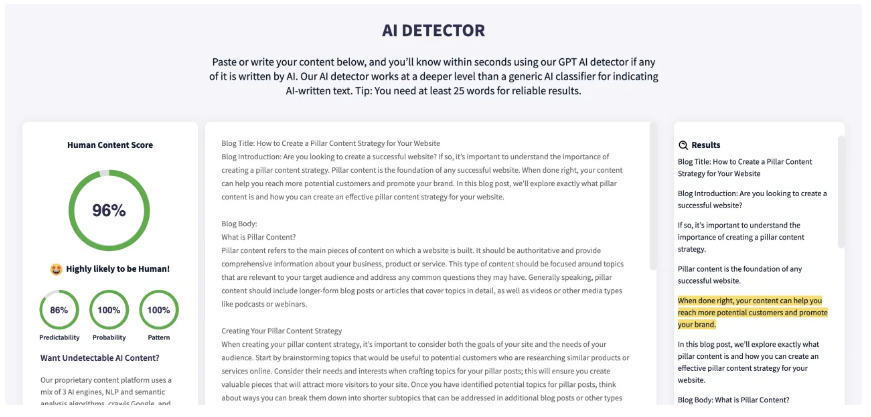
Key Features:
- AI detection across texts and images
- OCR technology
- Project and document management
Pros:
- Simple and straightforward result reporting
- Capability to rewrite identified AI text
Cons:
- Inconsistent quality in AI text rewriting
- Ambiguous accuracy rates
Best Suited For: Businesses and organizations needing to detect AI-generated text in their content.
Copyleaks stands out with meticulous sentence-level assessment, scrutinizing text authenticity with precision. It identifies AI-written source code and highlights segments potentially paraphrased to mask AI generation. Copyleaks is suitable for multinational enterprises and programming teams.

Key Features:
- Sentence-level assessments
- Detects all major AI models
- 30 language coverage
Pros:
- Granular assessment of text authenticity
- Over 99% stated accuracy
Cons:
- Slower result loading times
- Lacks partial text exclusion
Best Suited For: Multinational enterprises and programming/software development teams.
Crossplag’s AI Detector combines machine learning and natural language processing to determine if text is human-written or AI-created. Trained on an extensive dataset, Crossplag uncovers unique linguistic patterns. While not as accurate as advertised, it is a viable option for students and writers.
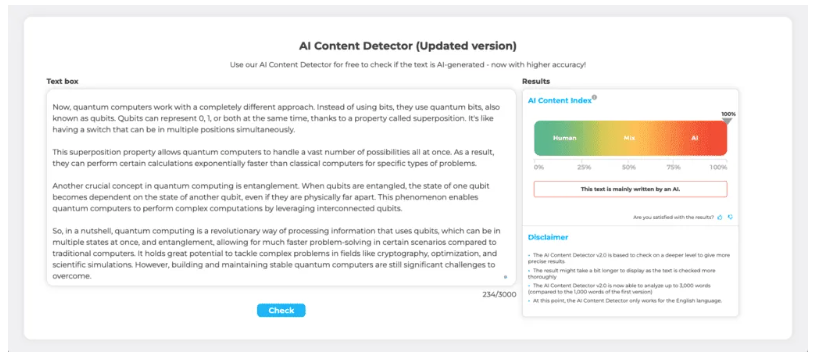
Key Features:
- Trained with over 1.5 billion parameters
- Detects subtly disguised instances of plagiarism
Pros:
- Easy to use
- Maximum accuracy with 1.5 billion parameters
Cons:
- Sign-up required
- Not very accurate
Best Suited For: Students, academics, bloggers, and all writers seeking to detect plagiarism.
GPTZero is an open-source AI detector tool that uses a multi-step approach to detect AI-generated content. While not as accurate as some other tools, it offers unique linguistic statistics and visually highlights text areas for easy identification.
Key Features:
- Dashboard with deep analysis view
- Visual highlights of text areas
- No sign-up required
Pros:
- Great dashboard view
- Unique linguistic statistics
Cons:
- Subpar accuracy levels
- Yes/no judgments only
Best Suited For: Education sector and researchers requiring an open framework for linguistic analysis.
Writer is a streamlined AI detector tool focusing on efficiently gauging text artificiality. While not as accurate as some other tools, it offers a simple and budget-friendly solution for writers looking to improve content or check public site pages.
Key Features:
- AI writing assistance
- Grammar/spell checking
- Plagiarism detection
Pros:
- Intuitive, straightforward use
- Direct URL analysis capability
Cons:
- Lacks color-coding of AI vs human text
- Not very accurate
Best Suited For: Writers seeking a simple and budget-friendly AI detection tool.
Concerns and Limitations of AI Content Detectors
While AI content detectors offer significant benefits, they are not without concerns and limitations:
- Accuracy Challenges: AI content detectors, despite their sophistication, may face challenges in accuracy. The evolving nature of AI algorithms and the constant development of new content generation models pose difficulties in creating detectors that can consistently and flawlessly differentiate between human and AI-generated content.
- False Positives and Negatives: There’s a risk of false positives and negatives. Content detectors may mistakenly identify human-generated content as AI-generated and vice versa. This inherent uncertainty underscores the importance of not solely relying on AI detectors and exercising human judgment.
- Technology Lag: The rapid pace of AI advancement can lead to technology lag in content detectors. Tools developed for specific AI models may struggle to keep up with newer, more advanced models, potentially rendering them less effective or accurate over time.
- Ethical Dilemmas: The use of AI content detectors raises ethical questions, especially in terms of privacy and data security. The analysis of content to determine its origin may involve processing sensitive information, necessitating careful consideration of ethical guidelines and user consent.
Conclusion
AI detection tools play a crucial role in maintaining content authenticity and upholding ethical standards in various domains. As AI technology continues to evolve, these tools will become even more sophisticated. Remember that AI detection is not about replacing human judgment but enhancing transparency and fostering an environment where originality and ethical authorship thrive.
Choose wisely based on your specific requirements, and stay informed about the advancements in AI detection technology. This guide aims to empower you with the knowledge needed to navigate the ever-changing landscape of content creation in the digital age.


![[SOlVED]Fix the Error of “System UI Isn’t Responding” on Android](https://www.techviewsolution.com/wp-content/uploads/2024/03/fix-system-ui-isnt-responding-error-on-android.png)
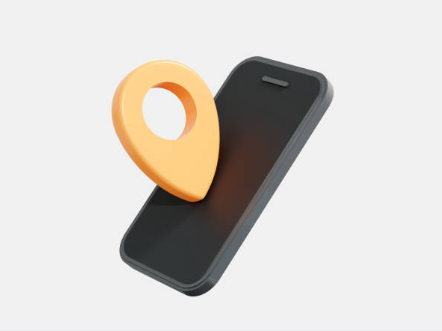
![How to Unsync iPhone From iPad [100% solved]](https://www.techviewsolution.com/wp-content/uploads/2024/03/unsync-iphone-from-ipad.png)
